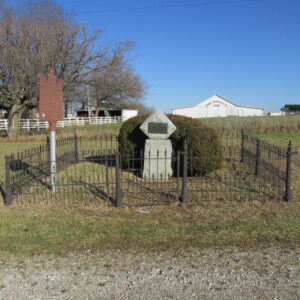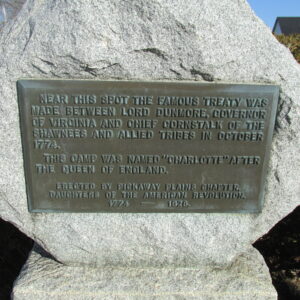Ohio makes revolutionary history-November 5, 1774
By Chris Matheney, Historic Site Manager, Ohio Statehouse
Early October 1774
Southern shore of the Ohio River

Captain William Crawford studied the far shore of the Ohio River once again through his spyglass. He had been ordered by Lord Dunmore, Royal Governor of the colony of Virginia, to build a stockade on the southern or Virginia side of the river.
The forest on the north side of the river seemed to come right down to the riverbank, a seemingly impenetrable wall of vegetation. He also had the sensation that he and his command were being watched by unseen eyes as he considered a different option, one that might place him in violation of his Lordship’s orders.
Taking a deep breath, he peered again through the lens noting the point of land jutting out from the north shore where the Hocking River flowed into the Ohio. Satisfied that it was the right decision, he closed his spyglass and began issuing orders…

Lord Dunmore’s War
250 years ago, during the spring, summer, and fall of 1774, the Ohio Country was the scene of intense violence. Lord Dunmore’s War refers to a series of bloody hostilities between the frontier population of Pennsylvania and Virginia, and the Native Americans living in the Ohio Country.
In response to the territory being in a constant state of alarm, Lord Dunmore raised an army of Virginians to carry the war deep into the Ohio Country in the summer of 1774-ultimately to strike the Shawnee villages along the Scioto River.
On October first of that year, he dispatched an expeditionary force of 500 men under the command of Captain Crawford to establish a fort as a jumping off place for the campaign.
Instead of erecting the fort on the southern side of the Ohio, Crawford made the choice to have his men cross the river and construct the fortification on a point of land located at the confluence of the Hocking and Ohio Rivers (today’s Hockingport, Ohio).
Fort Gower, the fort erected under Lord Dunmore’s orders was small by fortification standards containing a single blockhouse surrounded by a wooden stockade. It would withstand no attacks or sieges, yet it would help to light the fuse of the American Revolution.
Lord Dunmore’s Army returns after battle
After a series of battles with losses on both sides, a peace treaty was ultimately signed at Camp Charlotte near modern-day Circleville, Ohio.


News that would spark a revolutionary response
Returning to Fort Gower on November 5, 1774, Lord Dunmore and his entourage made an early departure leaving his army to disband and follow at their own pace.
The officers and men who were left at Fort Gower were delighted to receive news from the first Continental Congress that had taken place while they were on campaign.
The news was stirring, the Continental Congress, which had concluded its deliberations in Philadelphia had made a declaration demanding the repeal of the Intolerable Acts and a boycott on British goods.
The officers of Dunmore’s army then made their own assertion of rights and addressed the King in what has become known as the Fort Gower Resolves. These resolutions or resolves were an expression of defiance to Crown rule as the American Revolution was about to begin.
Meeting of Officers under Earl of Dunmore
“At a meeting of the Officers, under the command of his Excellency the Right Honorable the Earl of Dunmore, convened at Fort Gower, November 5, 1774, for the purpose of considering grievances of British America, an Officer present addressed the meeting in the following words:
‘Gentlemen: Having now concluded the campaign, by the assistance Providence, with Honour and advantage to the Colony and ourselves, it only remains that we should give our country the strongest assurance that we are ready, at all times, to the utmost of our power, to maintain and defend her just rights and privileges. We have lived about three months in the woods without any intelligence from Boston, or from the delegates at Philadelphia. It is possible, from the groundless reports of designing men, that our countrymen may be jealous of the use such a body would make of arms in their hands at this critical juncture. That we are a respectable body is certain, when it is considered that we can live weeks without bread or salt; that we can sleep in the open air without any covering but that of the canopy of heaven; and that our men can march and shoot with any in the known world. Blessed with these talents, let us solemnly engage to one another, and our country in particular, that we will use them to no purpose but for the honour and advantage of America in general, and of Virginia in particular. It behooves us then, for the satisfaction of our country, that we should give them our real sentiments, by way of resolves, at this very alarming crisis.’ Whereupon the meeting made choice of a Committee to draw up and prepare Resolves for their consideration, who immediately withdrew; and after some time spent therein, reported that they had agreed to and prepared the following Resolves, which were read, maturely considered, and agreed to, nemine contradicente, (“without a dissenting vote”),
by the meeting and ordered to be published in the Virginia Gazette:

The list of the officers and participants of this event in Ohio history would read like a Who’s who of the frontier. Many of them would go on to play a larger role in the American Revolution.
The Fort Gower Resolves appeared in the December 22, 1774, issue of The Virginia Gazette, published by Alexander Purdie and John Dixon. Further, the Resolves were read and entered into the records of the House of Lords in London. The Resolves were written almost six months before Lexington and Concord, and a year and a half before the Declaration of Independence. One of the first instances of the American Revolution-at a frontier fort in the Ohio Country.
-Chris Matheney is the Historic Site Manager of the Ohio Statehouse. This article contains excerpts from a forthcoming publication on the founding of Ohio that has been made possible by a generous grant from the Revolution 250-Ohio Commission.